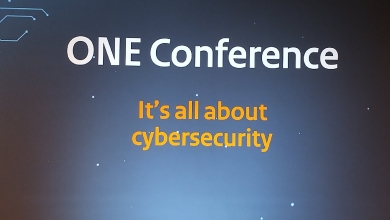
As previously reported, IT Europa attended this week’s cybersecurity ONE Conference in The Hague, which is the centrepiece of the city’s annual Cyber Security Week.
The week attracts delegates from across Europe and further afield, and stages various events and networking opportunities to bring the cyber tech industry and the government and public sectors closer together to tackle widening digital threats.
The event was opened by Dutch prime minister Dick Schoof (pictured left), and Dutch National Cyber Security Centre CEO Matthijs van Amelsfort (right). We sat down with Amelsfort to get his take on the size of the threat now facing business and governments.
This summer, Amelsfort and the National Cyber Security Centre were on red alert as The Hague staged the NATO summit, and had to contend with a nearby data centre fire and other incidents.
Last month, Amsterdam airport was closed because a pilot reported drone sightings, although others saw a balloon, not a drone.
It hasn’t been confirmed what was seen at the airport, but when we tried to fly in this Monday, Amsterdam was again affected, as it was closed down to just one runway for unexplained reasons, making hundreds of planes late.
Amelsfort acknowledged that such incidents were feeding into governmental and public concerns around cyber threats, even though the involvement of state actors or criminal players is often not proven. The data centre fire was serious, but not down to criminal intent, he said.
Asked whether he personally felt more at threat because of his responsibility for defending his country’s critical national infrastructure, Amelsfort said: “I was a police officer for 25 years, and know what threats are, and obviously I have to take precautions in connection with my job.
“But the main focus is the 50,000 threats we have to deal with every year, which involves threat management, and dealing with the greatest threats first.”
He said: “We deal with large amounts of calls and enquiries, and we can use AI to deal with them efficiently and help the public.”
AI is often seen as an emerging cybersecurity threat, but as far as Amelsfort’s unit is concerned, it can clearly be a useful tool.
We also paid a visit to the Clingendael Institute think tank, to get analysts’ take on emerging and potential global threats. Elon Musk probably won’t be happy that his name is contained in Clingendael threat reports also mentioning the likes of Iran, Isis, Russia, and China, but president Trump also got a shout in relation to cloud sovereignty.
While Elon Musk was considered because of his high worth, and his increasing propensity to intervene in other countries’ fractured politics, Trump’s seemingly widening grip on the technology sector isn’t seen as positive either.
The heads of leading US tech companies are cosying up to the administration, while Europe and other regions increasingly want tech independence from the US, not least in the cloud.
Maaike Okano-Heijmans, Clingendael Institute programme lead for Geopolitics of Technology and Digitalisation, said: “Trump is nothing new when considering new threats, but the cloud is seeing its 5G moment. China’s Huawei was excluded from Western 5G markets, and now Europe increasingly wants cloud sovereignty.”
She said a key focus for companies was how they could mitigate or cancel out the threat of having their data stored by US companies. Legally, both the US Patriot Act and US Cloud Act allows the US government to seize foreign citizen and company data if it is stored on the systems managed by US companies. And it doesn’t matter whether those systems are located in the US, Europe or anywhere else.
This is why Huawei was frozen out as Chinese companies are subject to the same type of law. Not that China is doing too badly on the tech front.
Okano-Heijmans said China was currently the “world leader” when it came to 57 of the 64 leading business technologies.
More to follow from Cyber Security Week in The Hague...

